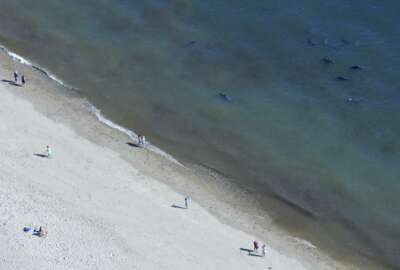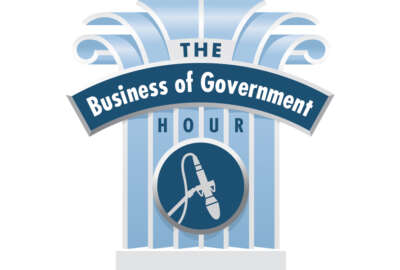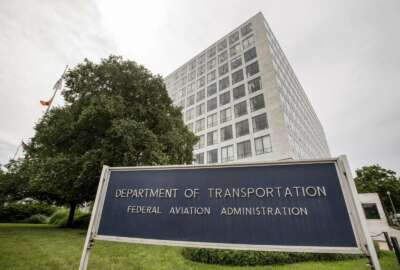
The Merchant Marine Academy confronts an urgent need to modernize itself
The U.S. Merchant Marine Academy produces the nation's trained and licensed maritime shipping workforce.
Best listening experience is on Chrome, Firefox or Safari. Subscribe to Federal Drive’s daily audio interviews on Apple Podcasts or PodcastOne.
It might be less well-known than its military academy counterparts. But the U.S. Merchant Marine Academy produces the nation’s trained and licensed maritime shipping workforce. So what it does is vital to the economy. The Academy is also in dire need of a new strategy and modernizing in general. That’s the conclusion of a panel convened by the National Academy of Public Administration. Panel chair Judith Youngman joined the Federal Drive with Tom Temin for more details.
Interview transcript:
Tom Temin: Ms. Youngman, good to have you on.
Judith Youngman: Thank you very much. I’m happy to be here.
Tom Temin: And what prompted this study? I know that NAPA studies are requested by Congress, nut what’s going on at the academy? And give us your top line findings here.
Judith Youngman: Well, in the National Defense Authorization Act of 2020, the Congress actually directed the Department of Transportation to undertake a comprehensive study of the Merchant Marine Academy. We were really tasked with looking at some specific areas like facilities, information technology, training programs, etc. But the overall goal was to look at it from a systemic point of view, and to make recommendations that we saw necessary for its modernization. But it was intended to be a comprehensive study.
Tom Temin: And you found that it basically, aside from the detail issues of facilities, IT training and sexual harassment, which we’ll get into a little bit, but it somehow doesn’t add up to a cohesive whole in the way it operates and is managed now, is my takeaway.
Judith Youngman: In terms of our top findings?
Tom Temin: Yes.
Judith Youngman: Well, the best way to describe our top findings and how we got there is really to talk a little bit about our process. And what we did is we hit the tasking that was in the NDAA, and began to delve into both specific issues, but also to be very sensitive to take a look at needs for modernization. We only got a few moments into the study, especially reviewing the early data, when we realized that there were significant issues at the academy. They were pretty much institution-wide, and when we began after a few months to delve down into, well, what are the causes of these issues, we realized that the root causes were the same in every single area covered in our study. We ended up delivering a 10-chapter report that looks at different facets. So we identified the common root causes, and those root causes of what we believe on the panel are our most significant findings. And I’m sure you’d like me to review what those root causes are.
Tom Temin: Well, what are the institutional wide issues, first? And then tell us what the root causes are.
Judith Youngman: The institution-wide issues are essentially included among the root causes. And they include, first of all, really a lack of a strategic vision for the Academy. And what I mean by that is not a strategic plan, which is typically about five years, but is there a commonly held vision of where the academy is going, where it will be, in 10 years? 15 years? 20 years? By mid century? So do they have a navigation path that they’re on? And we found that not only the academy, but also its oversight agencies, meaning MARAD, DoT, even the Congress and several of its advisory bodies, they all lacked a commonly held vision of, say, where should the academy be by 2050? That was key. The second major finding that we had, or the second major issue, was that the Academy has for some period of time — and I mean not years here, but perhaps even decades — has been seriously under resourced. It has lacked the financial support that it needs. It has lacked the number of staff in terms of its capacity and faculty capacity. But it has also lacked significant capabilities to enable it to really manage itself well, and to kind of chart that vision for the future. Another key finding that was also a root cause is a lack of effective oversight governance and guidance from its oversight agencies. And again, MARAD, DoT and the Congress, in terms of what the expectations are, you know, the maritime domain as we all know, the global shipping industry, is changing rapidly. And unlike the other service academies, the Merchant Marine Academy was kind of left to float on its own to try and figure out global trends. You know, the Naval Academy, the Coast Guard Academy, have whole services behind them that are telling them what that service needs today and what it needs in the future. And that’s not true with the Merchant Marine. Academy, because the global shipping industry is private, not public. So that was a really key gap, that there was this disconnect between where the maritime domain is going, and what the academies needs and roles should be in that maritime domain. And the final, I would say, major overarching conclusion was that the culture at both the Merchant Marine Academy in MARAD and in DoT had been for many, many years what we labeled a compliance culture. Meaning if a report comes out that says that there were certain things the academy must do, well, let’s do something. But that something was usually minimal. And so a great example of that is in the facilities and infrastructure area, in which report came out well over a decade ago called the Red Sky report about what the facilities and infrastructure needs were of the academy. And to be honest, our independent assessment came up with the same conclusion. So they’ve had the same conclusions for over 10 years. And yet, there has been very little action taken not just by the Academy, again, but by its oversight agencies. And this compliance culture ultimately was risk averse. And we think that these underlying root causes really left the Merchant Marine Academy adrift. And that is our major conclusion. We believe that the single greatest risk that the Merchant Academy faces today is inaction — doing nothing, doing only the minimum amount to satisfy people who are looking at our report and saying something needs to be done.
Tom Temin: Well, even for NAPA, this is really a tough one. And did you visit the place in-person? Or did members of the panel visit the place, and did it look rundown and kind of forlorn physically?
Judith Youngman: It looked sort of unkept physically. And yes, there was a site visit that included study team members, because NAPA isn’t just a panel of five and our projects, but we also have a professional study team that does a lot of the research. Because of COVID, the site visit was delayed a little bit, but we spent two days there. Three of the five members of the panel, plus half of the study team, spent time at the academy and had wide-ranging interviews in May. In addition, over a year ago, one study team member also spent days at the Academy, and really did some photo taking and taping of what was there as well. So we believe that we had adequate access to the Academy’s facilities and people. Of course, we use Zoom, as we all do these days as well.
Tom Temin: Sure. And so these issues are all basically leadership issues and senior staff types of issues. And they’re also DoT level issues. So how do you get at the problem? What were your major recommendations here?
Judith Youngman: Well, we call them governance issues. And one of the things that we tried to do, and of course our report had 67 specific recommendations. But we call them governance issues, as well as management issues. And the governance issues extend to those oversight bodies, like MARAD and DoT and the Congress. But also the academy itself, in terms of its internal management, is lacking some fairly standard management capabilities and capacities that you’d find in most federal agencies. So we identified both. In terms of our recommendations I said we had 67, and some of them are quite specific. But our number one recommendation is in our last chapter — chapter 10 — snd it is for the Secretary of Transportation to charter a senior-level group of leaders from the public and private sector to do a thorough assessment of the governance and the culture at the U.S. Merchant Marine Academy, and to help it chart a course into the future. We think that the task force must be at the senior level, the secretary’s level. We believe that it must include senior people, not existing staff, and people drawn from the maritime industries from the Department of Defense. Because of course, all Academy graduates served eight years in the reserves. And of course, the Merchant Marine itself is essential to the Department of Defense’s military Sealift Command, and they can be called into the Sealift Command at any time when the Merchant Marine capacity is needed. So we believe that should include a senior leader in higher education, especially undergraduate programs in STEM, a senior leader in change management, a senior leader in federal agency management, as well as in facilities and infrastructure. We also recommended three priorities for areas of priority for the task force. Number one, at the Merchant Marine Academy today, there are serious issues related to the health, safety and welfare not only of the midshipmen, but also for the staff and the faculty who work there as well. There are also serious issues on the horizon related to the academic standards and accreditation of the academy. And we believe that these issues must take the top priority of the task force. But because they involve health, safety and welfare, we also believe that it is essential for the Academy, MARAD, DoT and even the Congress to act immediately on these issues. But for the taskforce to then review what has been done by the time they’re established and then to make any recommendations that they see fit. Secondly, we believe that the task force should initiate and lead an effort to develop that strategic vision and course for the Academy looking ahead 10, 15 and 20 years, and that it should immediately target the governance issues. And by governance, I mean external as well as internal, but primarily looking at all of the oversight bodies — how they contribute to the academy, what their roles are, what their level of support is, what their oversight is, what governance they give — to make recommendations, but also to look at the existing advisory bodies that DoT or MARAD or the Academy have set up. Of course, the Congressional Board of Visitors are statutorily mandated and should continue. But there are other advisory committees, such as Meter B that’s internal to DoD, and some other advisory bodies. All of them should be on the table for the task force to recommend a way forward on improving the governance of the academy. Thirdly, once that governance body, or governance changes, are being made, thirdly, looking at the internal management of the academy is essential. It’s a strategic planning; it’s performance management systems and the way it engages in facilities and infrastructure in terms of a long-term planning process. Again, all the recommendations are in the report, but then thirdly, turn to the management of the Academy for the future.
Tom Temin: Sounds like they’ve got at least a 10-year job on their plans to write this ship, to use a bad pun.
Judith Youngman: Well, think of them as the architect of developing a plan that lays out the bones and the structure of what needs to be done, and then turning it over to the reformed to revise governance bodies to get it done. So we don’t see it being 10 years, but in our report we do not give it a timeline, although we do suggest it should be time limited.
Tom Temin: Judith Youngman is a fellow of the National Academy of Public Administration and chair of its panel on the U.S. Merchant Marine Academy. She’s also a former faculty member of both the Coast Guard and U.S. military academies.
Copyright © 2025 Federal News Network. All rights reserved. This website is not intended for users located within the European Economic Area.
Tom Temin is host of the Federal Drive and has been providing insight on federal technology and management issues for more than 30 years.
Follow @tteminWFED
Related Stories






